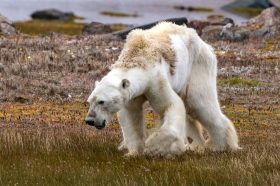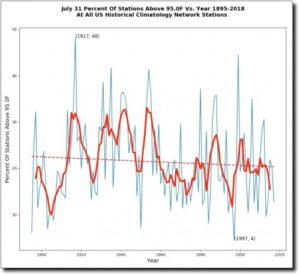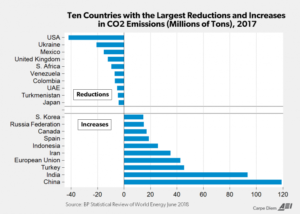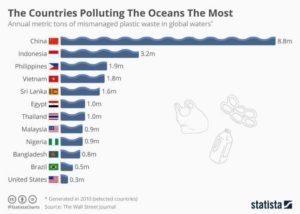by K. Richard, August 20, 2018 in NoTricksZone
Archives de catégorie : better to know…?
Remember when they told us coral bleaching was a sure result of recent man-made global warming? Never mind.
by Anthony Watts, August 17, 2018 in WUWT
From the “science eventually self-corrects” department, new science showing coral bleaching of the Great Barrier Reef is a centuries-old problem, well before “climate change” became a buzzword and rising CO2 levels were blamed.
Marc Hendrickx writes:
New paper shows coral bleaching in GBR extending back 400+ years.
…
Japan’s JMA Claim Of “Relatively Small” Urbanization Effect Likely An Understatement Of Multiple Degrees
by Kirye and P. Gosselin, August 17, 2018 in NoTricksZone/JapanMeteorologicalAgency
Aerial photos show that the 15 temperature observation stations the JMA is using to determine mean temperature anomalies are likely impacted far more by urbanization than the agency claims.
…
…
Abashiri is in the middle of buildings and streets.
Evidence for the impact of the 8.2-kyBP climate event on Near Eastern early farmers
by M. Roffet-Salque et al., August 13, 2018
This study reveals that animal fats preserved in pottery vessels from the United Nations Educational, Scientific and Cultural Organization (UNESCO) World Heritage site of Çatalhöyük recorded the abrupt 8.2-thousand years B.P. climatic event in their hydrogen isotopic compositions. In addition, significant changes are observed in the archaeology and faunal assemblage of the site, showing how the early farming community at Çatalhöyük had to adapt to climate change. Significantly, this contribution shows that individual biomolecules preserved in ancient animal fats can be used to reconstruct paleoclimate records and thus, provides a powerful tool for the detection of climatic events at well-dated onsite terrestrial locations (i.e., at the very settlements where human populations lived).
…
Evaluation du coût de blackout dans l’Union Européenne
by Ernest Mund, 13 aoüt 2018, in ScienceClimatEnergie
La fourniture d’électricité est essentielle au développement économique d’une nation et à son harmonie politique et sociale. Les profondes mutations subies actuellement par le système électrique dans lequel la part des énergies renouvelables intermittentes ne cesse d’augmenter, présentent des risques pour cette fourniture. Il importe d’en assurer la sécurité. Evaluer le coût d’un blackout est donc un élément d’information essentiel, qui devrait être pris en compte dans toute décision future d’investissement en matière de génération de puissance.
(…)
Climat : quand Nicolas Hulot joue à vous faire peur
by Samuele Furfari, 7 août 2018 in Contrepoints
Quelle aubaine pour les doctrinaires du développement durable ! Au moment de leur jour du dépassement il fait chaud, très chaud. Évidement ni l’écologisteHulot, ni France 2, ni France 24, ni la RTBF ni la ribambelle de médias impréparés ne pouvaient rater pareille occasion pour lier les deux évènements et nous culpabiliser pour introduire le contrôle de tous les détails de nos vies.
Ce premier août était donc le jour où, d’après Global Footprint Network (GFN), qui possède l’argent pour employer des dizaines de chercheurs souvent financés par les deniers publics, nous vivons désormais à crédit. À sa suite, toutes les ONG environnementales (ONGE) et nombre de politiciens se font les mégaphones de cette supercherie qui ne repose sur aucune base scientifique. Le jour du dépassement global (earth overshooting day) prétend être un indicateur dont l’objectif est de conscientiser et responsabiliser les pays développés à la notion d’empreinte écologique. Bien entendu, à part les Européens endoctrinés par les ONGE, cette théorie n’a guère d’écho dans le reste du monde.
…
Ours mourant de faim : l’aveu (tardif) d’une journaliste
by Tribune de Genève, 5 août 2018 in LesBlogs
Also FoxNews: Photographer behind viral image of starving polar bear raises questions about climate change narrative
Il y a juste un an, l’image d’un ours décharné et titubant avait fait le tour du monde. Elle était supposée représenter la réalité du réchauffement de l’atmosphère. Pourtant cette hypothèse n’était pas plus probable qu’une autre, par exemple: ours vieux, malade, mourant de mort naturelle.
…

Bad Disasters Happen, Again & Again
by C3Headlines, February 1, 2016
The below is a list of past severe weather events and natural disasters – prior to the consistent 350+ppm CO2 levels attained in the 1990’s. In addition, scattered throughout the list are interesting “expert” climate predictions and observations
…
See alos here
Polar Bear Dies, National Geographic Lies
by Donna Laframboise, August 3, 2018 in BigPictureNews
SPOTLIGHT: The iconic magazine is now a purveyor of propaganda.
BIG PICTURE: On her PolarBearScience.com blog last week, zoologist Susan Crockford called our attention to a startling admission over at National Geographic. It acknowledges publishing fake news. Or, as it more delicately puts it, we “went too far in drawing a definitive connection between climate change and a particular starving polar bear.”
An “Editor’s Note” explains the magazine added a wholly misleading caption to a video of an emaciated polar bear filmed last August. When it published this video on its website in December, National Geographic declared: “This is what climate change looks like.”
Actually, this is what dishonesty looks like. Neither the magazine nor the person who did the filming knew anything about that bear. It might have been stricken with disease. It might have sustained an injury that impeded its ability to hunt. As the Editor’s Note now admits: “there is no way to know for certain why this bear was on the verge of death.”
(…)
REALITY CHECK: MOST KING PENGUIN POPULATIONS HAVE BEEN INCREASING, NOT DECLINING
by Benny Peiser, August 1, 2018 in GWPF
Numbers of king penguins have increased throughout the Southern Ocean over the past 50 years.
…

Graph of the week – The strawman argument
by Anthony Watts, July 31, 2018 in WUWT
As many WUWT readers know, there’s this push to “save the planet” by banning plastic straws. Like most liberal Earth saving fantasies, it’s rooted in shonky science, or in this case, no science at all, just a guess.
…
A Geological Perspective of Wildfires
by David Middleton, July 31, 1018 in WUWT
This post was inspired by Anthony Watts’ recent post about wildfires and their unwillingness to cooperate with the Gorebal Warming narrative.
…
A Geological Perspective of Wildfires
The Fire Window
Geological evidence for ancient wildfires generally consists of sedimentary charcoal deposits (inertinite). Fossil charcoal is also a key factor in understanding the evolution of Earth’s atmosphere, particularly oxygen content. The first clear evidence of fire is in the Late Silurian.
…
Declining July 31 Temperatures In The U.S.
by Tony Heller, July 31, 2018 in ClimateChangeDispatch
July 31 afternoon temperatures have been declining in the US for a century, with the hottest year being 1917 when almost half of the US was over 95 degrees.

Meat, Dairy Industry Surpass Big Oil As World’s Biggest Polluters
by P. Homewood, July 31, 2018 in NotaLotofPeoppleKnowThat
Within the next few decades, Big Meat and Big Dairy could surpass Big Oil as the world’s biggest climate polluters, a new study by non-profit GRAIN and the Institute for Agriculture and Trade Policy (IATP) showed on Wednesday.
The world’s biggest animal protein producers could soon surpass ExxonMobil, Shell, and BP as the largest contributors to climate pollution, according to the study.
IATP and GRAIN jointly published the study that quantifies emissions from 35 of the world’s largest meat and dairy companies and reviews their plans to fight climate change.
The report found out that the five largest meat and dairy corporations combined – JBS, Tyson, Cargill, Dairy Farmers of America, and Fonterra – are already responsible for more annual greenhouse gas emissions than ExxonMobil, Shell, or BP. According to one figure in the report, the combined emissions of the top five companies are on par with those of Exxon and significantly higher than those of Shell or BP.
The truth behind the Baffin Bay starving polar bear video is worse than we thought
by P. Homewood, July 263, 2018 in NotaLotofPeopleKnowThat
Remember that video of an emaciated Baffin Island polar bear that went viral last December? In an unexpected follow-up (“Starving-Polar-Bear Photographer Recalls What Went Wrong“; National Geographic, August 2018 issue), photographer Cristina Mittermeier makes some astonishing admissions that might just make you sick.
…
Susan Crockford uncovers the truth behind that “starving polar bear video”
La terrible canicule de l’été 1911 qui provoqua 40 000 morts
by Pierre Bienvault, 22 juin 2017 in LaCroix
Encore dans toutes les mémoires, la canicule de 2003 et ses 15 000 morts n’a pas été la plus meurtrière de la France du XXe siècle.
Il faudra marquer cette année 1911 d’une croix noire. » Voilà ce qu’écrivait, à la fin de l’été, un médecin du département de la Seine inférieure. À l’évidence traumatisé par les conséquences de la terrible vague de chaleur qui frappa alors, de juillet à septembre, toute l’Europe mais surtout la France et la Belgique. « Pendant la longue période de chaleur, la mort n’a cessé de faucher les tout-petits élevés au biberon », ajoutera ce médecin.
Une canicule de juillet à septembre
Encore dans toutes les mémoires, la canicule de 2003 et ses 15 000 morts n’a pas été la plus meurtrière en France. C’est ce que rappelait Catherine Rollet dans un article (1) paru en 2010. Cette historienne et démographe, décédée en décembre 2016, y racontait la dramatique canicule de l’été 1911.
…
Hiding The Inconvenient Satellite Data
by Tony Heller, July 25, 2018 in TheDeplorableClimateScienceBlog
In 1972, forty-two “top European and American investigators” predicted a rapidly approaching new ice age – based on an increase in snow and ice cover from 1967-1972.
The technique employed ….. depends on the averaging of information from standard and ‘infra-red satellite weather pictures.
…
How the Little Ice Age affected South American climate
by Fundação de Amparo à Pesquisa do Estado de São Paulo, July 24, 2018 in ScienceDaily
A new study published in Geophysical Research Journal shows that the so-called Little Ice Age — a period stretching from 1500 to 1850 in which mean temperatures in the northern hemisphere were considerably lower than at present — exerted effects on the climate of South America.
Based on an analysis of speleothems (cave formations) in the Brazilian states of Mato Grosso do Sul and Goiás, the study revealed that in the seventeenth and eighteenth centuries, the climate of southwestern Brazil was wetter than it is now, for example, while that of the country’s Northeast region was drier.
The same Brazilian cave records showed that the climate was drier in Brazil between 900 and 1100, during a period known as the Medieval Climate Anomaly (MCA), when the northern hemisphere’s climate was warmer than it is now.
…
Why we’re winning: WUWT gets more page views than the last two remaining government websites on climate
by Anthony Watts, July 17, 2018 in WUWT
(…)
While NBC News might think that 68,000 page views per month is impressive, in comparison to our regular daily traffic on WUWT, it pales in comparison. For example, here is a screencap from my WordPress dashboard from yesterday, July 16th, which was a fairly typical summer day for WUWT. Note that it shows 92,467 page views in one day.
…
What’s most interesting is that while there’s been a slow, almost imperceptible increase in the phrase “climate change”, the search phrase “global warming” is getting far less use than it did when data was first collected, back in 2004. Right now, both “climate change”, and “global warming” have low interests.
Chart of the week: The US is the leader in CO2 emissions reduction
by Anthony Watts, July 16, 2018 in WUWT
From the American Enterprise Institute via Twitter. h/t to WUWT reader “Latitude”
Last year the United States had the largest decline in CO2 emissions *in the entire world* for the 9th time this century.

From the June 2018 BP Statistical Review of Global Energy (67th edition) here are some details on C02 emissions in 2017: (…)
Sound waves reveal diamond cache deep in Earth’s interior
by Jennifer Chu, July 16 in MITNews
There may be more than a quadrillion tons of diamond hidden in the Earth’s interior, according to a new study from MIT and other universities. But the new results are unlikely to set off a diamond rush. The scientists estimate the precious minerals are buried more than 100 miles below the surface, far deeper than any drilling expedition has ever reached.
The ultradeep cache may be scattered within cratonic roots — the oldest and most immovable sections of rock that lie beneath the center of most continental tectonic plates. Shaped like inverted mountains, cratons can stretch as deep as 200 miles through the Earth’s crust and into its mantle; geologists refer to their deepest sections as “roots.”
In the new study, scientists estimate that cratonic roots may contain 1 to 2 percent diamond. Considering the total volume of cratonic roots in the Earth, the team figures that about a quadrillion (1016) tons of diamond are scattered within these ancient rocks, 90 to 150 miles below the surface.
L’hydrogène géologique ou hydrogène naturel : Etat de la question
by A. Préat, 16 juillet 2018 in ScienceClimatEnergie
L ’hydrogène, un gaz peu abondant…
L’ hydrogène n’est présent qu’à concurrence de 1 ppm ( = une ‘partie par million’, soit 0,0001%) dans l’atmosphère : autant dire que c’est presque rien. D’où vient-il ? Peut-on en produire de grandes quantités à partir de ressources naturelles (géologie) ou artificielles (chimie) ? Autant de questions que de plus en plus d’industriels, de scientifiques, de politiques et de citoyens (?) se posent pour faire face à ce qu’il est convenu d’appeler la transition énergétique tant à l’ordre du jour, à raison ou à tort, là n’est pas l’objet de cet article. Comme nous le verrons par la suite, l’exploitation directe de l’hydrogène naturel n’est pas encore rentable et il faudra sans doute le produire à partir d’une autre source d’énergie, car il n’est pas lui-même une source d’énergie, mais au contraire un simple vecteur d’énergie.A l’heure actuelle il n’est donc pas exploité à une échelle suffisante en raison des contraintes géologiques et économiques, et il faut le synthétiser [1]. C’est ce que réalise aujourd’hui l’industrie principalement en vue de la fabrication de l’ammoniac pour les engrais ou des plastiques.…
Diesel cars are still the most sensible option for long journeys despite pledge to wipe vehicles from roads by 2040, says transport secretary
by James Salmon, July 9, 2018 in DailyMail
Diesel cars may still be the most sensible option for many families who drive long distances, the transport secretary Chris Grayling said yesterday.
Despite a pledge to see the end of petrol and diesel vehicles on UK roads by 2040, Mr Grayling said new diesels were not destined for the scrapheap just yet.
He said: ‘If you are doing long distances on the motorway, maybe the new generation of diesel engines are the right option for now.
…
Warm world? Look at the cold all over the map
by Robert, July 9, 2018 in IceAgeNow
If you were to believe the mainstream media, you’d think our world is burning up. But that is not true.
Yes, there were places on our planet where it was warmer than normal today. But many parts of the world displayed normal or even colder than normal temperatures.
Look at all of the white and blue on this map.

…
‘The Earth has a fever’ – the only solution is 14 billion air conditioners
by University of Birmingham, July 10, 2018 in WUWT
…
According to the report, if we are to take cooling demand seriously, the key stages to move towards a solution for cooling demand are:
-
Reducing the energy required for cooling: getting industry to adopt high efficiency cooling technologies and using maintenance to deliver optimum performance.
-
Reducing the need for cooling through better building design
-
Systems level thinking across built environment and transport
-
Harnessing waste resources: ‘wrong time’ renewables; waste cold; and waste heat.
-
Considering the strategies and skills required for installing appliances and maintaining them in order to maximise efficiency and reduce energy demand
-
Creating a model for delivery of affordable cooling to those in rural and urban communities based on the energy needs of local requirements, rather than imposing a ‘one size fits all’ approach
-
…


